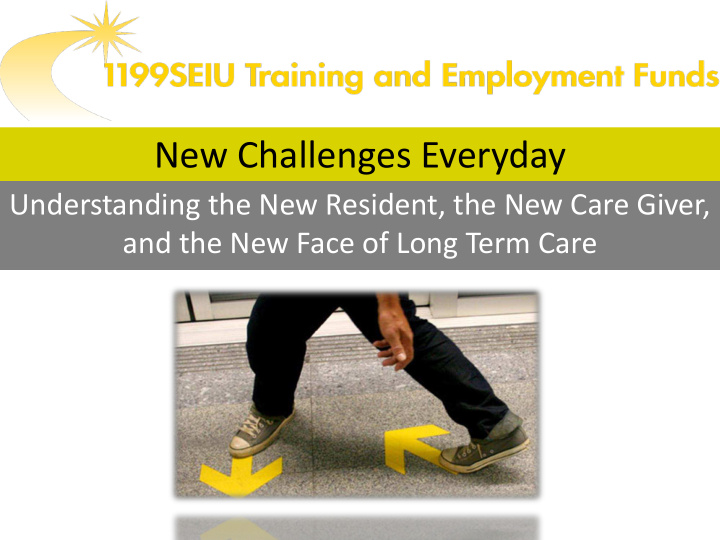



New Challenges Everyday Understanding the New Resident, the New Care Giver, and the New Face of Long Term Care
Sakara Bey 1199 League Labor Management Project Labor Management Consultant 8 Years of Experience in working in Long Term Care
109,257 Residents 50,000 Nursing Home Workers 657 Nursing Homes 3 rd largest in the LTC provider in the country based on # of beds
Workshop Objectives By the end of this workshop, we should be able to identify: – Current changes impacting long term care – Strategies some organizations are using to prepare – Useful information to share and prepare one’s self for the future of long term care
Who’s in the Room? Please share your: – First name – Title – # of years working in long-term care – Do you plan to live in a nursing home? • Why? • Why Not?
Major Influences on LTC in America • Religion • War • Government Social Security Act of 1935 Medicare & Medicaid Laws of 1965 Omnibus Reconciliation Act (OBRA) of 1987
The Age of the Consumer
Today’s Drivers for Change Consumer Preference Means: Less Restrictive Settings More Independence Integration with the Community Adaptability for Differing Acuity Meeting Individual Needs Non- institutional alternatives
Just the Facts: 2010 • There are 1.7 million nursing home beds in the US • Major changes in reimbursement system – Readmissions – Pressure ulcers – Increased regulations – Heightened surveyor pressures – Increased pressure for documentation • Enhanced consumer awareness (shop around!) – Nursing Home Compare
How are You Feeling the Impact? Lack of Staffing Lack of Resources Failing Plants Inadequate amount of time spent with the Residents Too little on-going education Less with More!
Nursing Homes Have Few Options… Typical Nursing Home Budget: People: 73% Supplies & Overhead: 20% Building: 7%
If consumers have the money… And nursing homes don’t…
Where’s the Money? • US spent more than any industrialized country on healthcare 2.2 Trillion Dollars • The nursing home industry is the second most regulated industry in America (only beat out by the nuclear industry) • Most nursing homes get most of their funding from the government — nearly half – In 2000, 44 billion was spent on NH care, 6 billion on home and community based care, an increase of 20 billion 10 years prior.
And they’ve Heard All About…
Carving a NEW Landscape Want to live at home Home-like Settings Autonomy over daily routines Focus on living not care Consistent Care givers
Administrator/Owner Residents Managers/Supervisors Non Clinical Staff/Direct Care Givers Non Clinical Staff/Direct Care Givers Administrator/Owner Residents
Video clip
Bill Thomas’ Green House
• Smaller living rooms with Household Model entertainment units • Reception desks and fireplaces • Laundry for 24 people • Small groups of residents -- 48 residents in each Household, subdivided into living areas of 12 residents to a living/activity area • Pets, plants, fish aquariums for all to enjoy • Patio & garden
Quality Care Community
Federal Response • F172 – Access and Visitation • F175 - Married Couples • F421 – Dignity • F 242 – Self Determination & Participation • F 246 – Accommodation of Needs • F247 – Roommate Change • F252 – Environment • F256 – Lighting • F371 – Sanitary Conditions • F461 – Resident Rooms
But wait….there’s more! • These F-Tags must be coordinated with the following to receive maximum payment: – The MDS – Care Planning/ADLs – Admissions and Assessment Process • RUGS, QIS, MDS 3.0 • Pay 4 Performance – Quality Improvement
The Future Resident By 2030, it is projected that 70 million Americans will be 65 or older and 8.5 million be age 85 or older At current usage rates, there will be 3 million residents living in nursing homes More than half will need assistance in all five ADLs
The Future Resident • More of Them • Longer Life Spans – Sicker, longer • More Chronic Disease – Hypertension – Diabetes – Cancer – Alzheimer's/ Dementia
How Will the Changes Impact Care?
Changing Models of Care Delivery New Frameworks Staffing Implications • Electronic Medical • Culture Change Records • Resident-Centered Care • Documentation • Person-Centered Care • Cross title jobs • Person Before Task • New job descriptions • Empowerment • Less Managers • Engagement • More Skills required • Increased Safety Issues • Assessments • Varying Acuity Levels
The New Nursing Home
The Care Provider • Be Proactive… How best to prepare? – Get involved – Educate yourself – Help Steer direction • Be Open… – Work differently – Confusion is ok – Rely on teamwork • Be Nimble… – Start projects that are multi-discipline – Expect the unexpected
Web Resources Available • www.QualityCareCommunity.org • www.PioneerNetwork.net • www.1199.org • www.edenalt.org • www.greenhouseproject.org • www.phinational.org • www.cms.hhs.gov • www.NursingSociety.org • www.annalsoflongtermcare.com
Today’s Resources • NYU/Hartford Institute for Geriatric Nursing – Issues Paper • Retooling for An Aging America: Building the Healthcare Workforce • Pioneer Network’s: Nurse Leaders’ Competency Survey for Culture Change • Local community College • Blurring of Responsibilities Worksheet • Summary of New F- Tags • QCC Newsletters and Information Sheets
References • www.cdc.gov • www.healthinaging.org • www.kff.org • http://www.startribune.com/local/east/40261 707.html?page=3&c=y • http://www.consumeraffairs.com/news04/gre en_house.html#ixzz0j1Z6SzmN • www.Webmd.com • http://www.hsph.harvard.edu/chc/reinventin gaging/Report.pdf
Sakara Bey 1199 League Labor Management Project Sakara.bey@labormanagementproject.org 212.894.4314
Recommend
More recommend